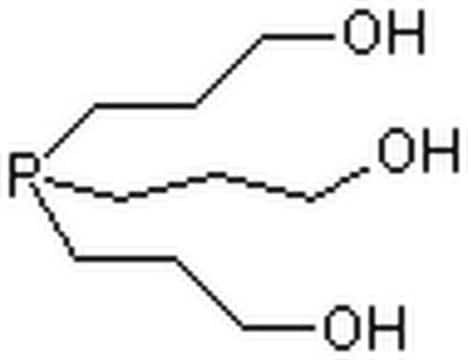68957
Tris(2-carboxyethyl)phosphine hydrochloride
BioUltra, suitable for electrophoresis, SDS-PAGE tested
Synonym(s):
TCEP.HCL, TCEP
About This Item
Recommended Products
product line
BioUltra
Assay
97.5-102.5%
form
powder
technique(s)
electrophoresis: suitable
solubility
H2O: soluble
suitability
SDS-PAGE tested
SMILES string
Cl[H].OC(=O)CCP(CCC(O)=O)CCC(O)=O
InChI
1S/C9H15O6P.ClH/c10-7(11)1-4-16(5-2-8(12)13)6-3-9(14)15;/h1-6H2,(H,10,11)(H,12,13)(H,14,15);1H
InChI key
PBVAJRFEEOIAGW-UHFFFAOYSA-N
Looking for similar products? Visit Product Comparison Guide
Related Categories
General description
Application
Features and Benefits
- TCEP.HCL lowers reactive oxygen species levels.
- It increases glutathione levels and mitochondrial content.
- It has anti-cancer effects.
Analysis Note
Signal Word
Danger
Hazard Statements
Precautionary Statements
Hazard Classifications
Eye Dam. 1 - Skin Corr. 1B
Storage Class Code
8A - Combustible corrosive hazardous materials
WGK
WGK 1
Certificates of Analysis (COA)
Search for Certificates of Analysis (COA) by entering the products Lot/Batch Number. Lot and Batch Numbers can be found on a product’s label following the words ‘Lot’ or ‘Batch’.
Already Own This Product?
Find documentation for the products that you have recently purchased in the Document Library.
Customers Also Viewed
Articles
Workflows for monoclonal antibody adalimumab characterization ensure drug safety and efficacy through critical quality attribute analysis.
Workflows for monoclonal antibody adalimumab characterization ensure drug safety and efficacy through critical quality attribute analysis.
Workflows for monoclonal antibody adalimumab characterization ensure drug safety and efficacy through critical quality attribute analysis.
Workflows for monoclonal antibody adalimumab characterization ensure drug safety and efficacy through critical quality attribute analysis.
Protocols
SEC-MS protocol for rapid glycoprofiling of monoclonal antibodies with antibody purification and mass spectrometer calibration.
SEC-MS protocol for rapid glycoprofiling of monoclonal antibodies with antibody purification and mass spectrometer calibration.
SEC-MS protocol for rapid glycoprofiling of monoclonal antibodies with antibody purification and mass spectrometer calibration.
SEC-MS protocol for rapid glycoprofiling of monoclonal antibodies with antibody purification and mass spectrometer calibration.
Our team of scientists has experience in all areas of research including Life Science, Material Science, Chemical Synthesis, Chromatography, Analytical and many others.
Contact Technical Service









